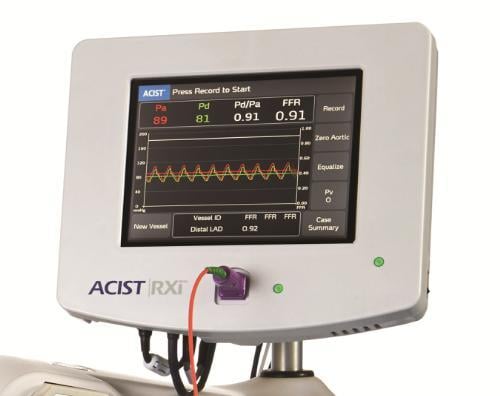
May 30, 2017 — Early results from the independent, physician-sponsored FFR-Search Registry revealed an association between post-percutaneous coronary intervention (PCI) fractional flow reserve (FFR) measurements with the Acist Navvus Rapid Exchange FFR MicroCatheter and clinical outcomes. The results reveal a potential new role for FFR in cath labs.
These early findings were presented during a late-breaking trial session at EuroPCR 2017, May 16-19 in Paris France.
The investigators from the Erasmus Medical Center found that microcatheter-based FFR was feasible in various clinical settings, including acute coronary syndromes and ST elevation myocardial infarction, and almost half of patients had an FFR lower than 0.90 after PCI. As anticipated, these early results did not have a meaningful impact on 30-day clinical outcomes; patients will now be followed out to the two-year primary endpoint to shed more definitive light on the value of post-PCI FFR in clinical practice.
The registry enrolled over 1,000 consecutive patients with stable angina or acute coronary syndromes that had undergone PCI at Erasmus Medical Center in Rotterdam to determine the association of post-PCI FFR values on clinical outcomes, as measured at 30-days, one-year, two years and five years follow-up. In an attempt to replicate real-world clinical practice, the protocol precluded operators from additional optimization techniques after the initial stent placement.
Using the ACIST Navvus Rapid Exchange FFR MicroCatheter — an ultra-thin monorail microcatheter with fiber-optic technology — the average post-PCI FFR value was 0.96 in a resting state and 0.91 under hyperemic conditions in the 959 patients who were able to undergo FFR measurement. Utilizing the microcatheter technology allowed the investigators the unique benefit of delivering the pressure sensor diagnostic directly over any 0.014-inch workhorse guidewire post-PCI and only added approximately 5 minutes to the overall procedural time. Interestingly, 22 percent of patients whose lesions were stented still had at least one post-PCI FFR measurement less than or equal to 0.85. The primary clinical endpoint is MACE defined as all-cause mortality, myocardial infarction (MI) and any revascularization.
The initial 30-day data found that FFR measurements greater than 0.9 resulted in a MACE rate of 1.5 percent, while measurements less than 0.9 resulted in a MACE rate of 2.3 percent (p=ns). Furthermore, as the FFR measurements decreased in patients, the MACE rates numerically increased. While the patient cohorts with FFR measurements below 0.90 were underpowered to show statistical differences between groups, FFR measurements in the 0.86-0.90, 0.81-0.85 and less than or equal to 0.80 ranges resulted in MACE rates of 2.0 percent, 2.6 percent, and 2.8 percent, respectively.
“As FFR becomes more and more the standard to determine treatment approaches in patients with coronary artery disease, we are excited to see that this technology is safe, fast and easy to apply — as well as may be used to optimize longer-term outcomes after interventional procedures,” said FFR-Search investigator Nicolas M. Van Mieghem, M.D., Ph.D., FESC, co-principal investigator and director of interventional cardiology at Thoraxcenter, Erasmus Medical Center in Rotterdam, Netherlands. “The preliminary data from FFR-Search has the potential to significantly expand this technology’s role in the cath lab in the future, which is why we’re eager to see the important results of the primary endpoint at two years.”
In 60 of the patients having an FFR value equal to or less than 0.85, an intravascular high-definition ultrasound analysis was performed to identify potential causes for the low post-procedural FFR measurement. Stent under-expansion was the most frequently identified cause for low FFR, found in 84 percent of the cases, followed by focal lesions distal to the stent (52 percent), focal lesions proximal to the stent (43 percent) and stent malapposition (22 percent).
“Based on these results, we look forward to continuing to build the evidence supporting this new role of FFR,” said FFR-Search co-investigator and presenter Roberto Diletti, M.D., interventional cardiology at Thoraxcenter, Erasmus Medical Center in Rotterdam, Netherlands. “We are eager to see how the outcomes will unfold at one, two and five years, and how we may be able to best optimize these findings through further intervention after the post-treatment FFR measurement.”
Unlike traditional pressure wires, the Acist RXi Rapid Exchange FFR System and Navvus Rapid Exchange FFR MicroCatheter, allows physicians to use their 0.014-inch guidewire of choice throughout the procedure, addressing challenges of pressure wires, including accessibility in challenging anatomies, maintaining wire position, pressure‐measurement drift and ease of obtaining post‐intervention FFR.
For more information: www.acist.com


 December 20, 2023
December 20, 2023 








